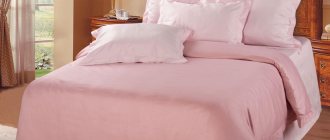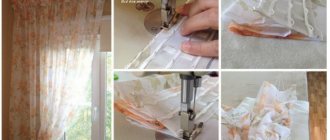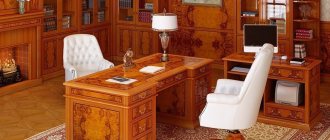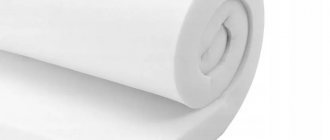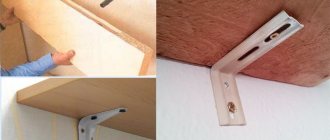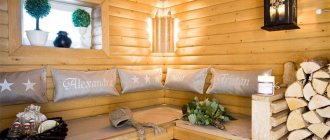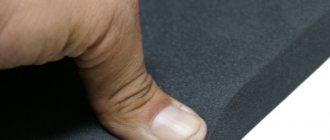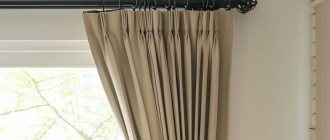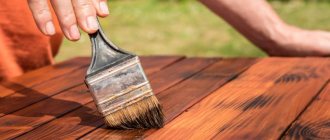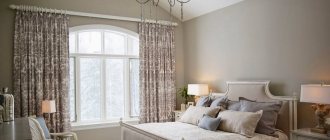Home / Different composition
Back
Published: 11/15/2020
Reading time: 3 min
0
539
At first, exquisite dresses for rich young ladies were made from thin fabric resembling lace. In the old days, only representatives of the aristocracy knew what tulle was. Now curtains made of translucent veil, flowing chiffon, and airy mesh, which are used when decorating windows, bring harmony to the interior, create a calm atmosphere, and complement any design project.
- 1 History
- 2 Fabric production
- 3 Types of tulle fabrics, their compositions and properties
- 4 Pros and cons of fabric
- 5 Application of the canvas
- 6 Tips for choosing fabric for clothing and interior design
- 7 Care
What type of fabric is this?
Tulle is a translucent lightweight fabric that is now primarily used for window decoration. It can be smooth or patterned and have varying degrees of light transmission.
The fabric is made from cotton and silk threads with the addition of polyamide and polyester to smooth the fabric or apply a pattern to it.
Polyester
What are polyester types of fabrics, how did they appear and what are their properties?
more details
Polyamide
What is known about synthetic polyamide fabric and where is it used?
more details
The material is now produced on an industrial scale using special equipment. To do this, first the fiber and threads themselves are prepared and installed, and then the tulle is sewn from them.
After this, it is additionally subjected to a number of processing works:
Boiling
Whitening
Widening
Calendering
The finished patterned or mesh fabric is rolled into rolls, packaged and sent to warehouses.
Tulle and style
Tulle supports the style of the living room.
There are many interior styles - thematic ideas that govern all pieces of furniture, accessories and textiles as well. There are different styles in which the living room can be designed:
- Baroque - interiors in this style evoke one association: luxury, chic. Living rooms of this type are filled with exquisite things - voluminous armchairs, sofas, tables with curly legs, paintings in gilded frames, stucco on the ceiling. Curtains are chosen to be heavy, thick, often with gold or silver. Elite tulle is also selected - patterned, lace, with embroidery. The color of the tulle should be in harmony with the prevailing tones in the interior.
- Classic means practical furniture, the predominance of functional details and at the same time the overall aesthetic appearance of the room. This style can be called solemn, even ceremonial. Often in a classic interior you can see lush curtains with folds in the form of smiles, lambrequins and complex draperies. Tulle can be either light or more saturated - cherry, chocolate, blue.
- Minimalism is a laconic style; the room should have a lot of air and a minimum of decorations. Tulle is chosen white or vice versa, rich gray, black, dark blue. Minimalism is a style with a masculine character; window design should be as simple as possible.
- Provence is a light and airy French style. Tulle is used in delicate, light shades (white, lilac, transparent wave colors). The color combination of tulle with decorative sofa pillows and bedspreads looks lovely.
- Eco - often merges with the “rustic” country style. Natural materials are used in the interior - linen, cotton, wood. It’s good if the tulle is beige, golden, sandy - the window textiles should not stand out.
If tulle is used in conjunction with some other type of curtain, it is usually simply hung on a curtain rod and straightened to form soft folds. If this delicate fabric becomes an independent accent, you can drape it without hesitation to show your imagination. To create a charming textile design, you can use two pieces of tulle (even in different colors) - they are collected using pins or braid, thrown through eyelets, lightly woven together, and layered. If the tulle is well decorated and you want to show it to guests, then you can only add lambrequins that will not hide patterns or metallic threads.
Origin story
The history of tulle begins in the 9th century with the city of the same name in France. It is believed that the king, who wanted to marry off his daughter, faced a big problem - she did not want to go out in public with her face open.
Then the caring father ordered to sew a fabric that would cover the outline of the girl’s face, but would allow her to see what was happening outside. So, local weavers made the first tulle in a few weeks.
However, the material became widespread only in the 19th century. Then it quickly spread throughout the world and began to be used in sewing dresses, veils, and making interior items. At that time, its production was carried out entirely manually, but already in the 20th century this process was automated, which ensured mass availability of the fabric.
Style decision
Universal window decor allows you to highlight any interior style.
Modern style
For a modern interior, a plain tulle, striped, with a little embroidery is suitable. The color does not matter, but it should be appropriate in the decor. Simple lines, clear fabric without asymmetry are welcome in a modern style.
Classic style
The classic interior lies in the consistency and combination of heavy brocade or velvet curtains with light patterned muslin in beige or white, as well as a soft lambrequin or sash with fringe and tassels. When sewing, it is important to take into account that the tulle does not reach the floor by 2 cm, and the curtains lightly touch it.
The photo shows a classic interior, where the curtains are attached to a closed baguette. Fastening with braid ensures frequent drape of the fabric.
Provence
For Provence, a light texture of fabric is suitable, which can be easily draped in lush folds on the sides of the window. Mesh, tulle with embroidery, and a floral pattern are suitable. The length can be any, depending on the interior and size of the room.
Scandinavian style
The Scandinavian interior does not imply the use of heavy curtains, so white muslin without openwork and a simple cut is suitable here. It can also be combined with a roller blind.
Fabric composition and its properties
The basis of modern tulle is polyester and polyamide fibers obtained by chemical means. Due to their improved characteristics, the manufactured material is more durable and has many design options. Blended yarn is also often added to tulle.
Polyamide threads are used to produce smooth and elastic tulle, while polyester fibers allow you to create ornaments and patterns on the material.
Tulle properties:
Subtlety, airiness
Minimum weight
The fabric has almost no stretch
Good light transmission and ability to diffuse light.
However, keep in mind that the composition of the tulle fabric determines its properties and operating characteristics, so when purchasing fabric, pay attention to the manufacturer’s recommendations and instructions.
How to choose tulle for the living room
The whole family gathers in this room, welcomes guests, holds feasts and parties. When choosing tulle for the living room, keep in mind that it must match the overall style of the interior. Curtains can be given the role of the main decoration or background, emphasizing the features of the environment.
The living room, unlike the bedroom and nursery, does not need complete shading, so there is no need to overload the windows with excess fabric - tulle looks great even without curtains. Medium-density material is usually enough to protect the room from views from the street. And in cases where the room is located in a country house or on a high floor, there is no need for such protection at all - you can decorate the windows lightly and airily, in accordance with the requirements of modern design, saving on heavy curtains.
Tulle curtain GARDEN organza
In a small living room with small windows, tulle without lush draperies, only slightly gathered on the cornice, will be the most appropriate option. It doesn’t matter what length it will be - short or floor-length. The presence of a lace pattern will provide privacy. Multilayer combined curtains with large patterns and deep vertical folds, flowing from the ceiling to the floor, are ideal for a spacious hall.
If there is no clear concept to adhere to, decorate the windows with pastel-colored canvases made of soft, smooth or lace fabric.
Types of fabric
The concept of “tulle” includes many varieties of curtain fabric, the range of which is actively expanding.
Types of tulle:
A very thin fabric, the structure of which contains many tightly twisted fibers. Despite this, it is weightless and airy.
Organza
Lightweight and pliable fabric, which is also thin, but hides everything that is behind it. The canvas wrinkles quickly, which is why it requires special care.
Veil
Mesh Mesh tulle is most often used as interior materials, since it practically does not block the room and allows light and air to pass through well.
A material consisting of connected tulle fibers in the form of small cells.
Fatin
Nylon Transparent synthetic tulle fabric that stretches, does not wrinkle and is highly durable. The only negative is that nylon is afraid of high temperatures.
Premium tulle, which is created through an interesting interweaving of fibers that creates repeating patterns. Jacquard fabric has a high price and is often made to order.
Jacquard
What types of tulles are there?
Tulle is a general term. Tulle is a translucent and transparent, delicate, light, flowing fabric. This term refers to smooth, mesh or woven patterned fabrics, here are some of their varieties:
- lace is an openwork textile with an interweaving of natural or synthetic threads in the form of an elegant pattern, the elements of which are interconnected, without a fabric base, the openwork elements rhythmically alternate with a dense pattern;
- guipure (French lace) - openwork airy fabric with a lace pattern on a mesh;
- organza - elastic transparent or translucent fabric made of synthetic fibers, with shine and shimmer;
- crystallon - a type of organza, thin, light, translucent fabric, durable, elastic;
- veil - translucent delicate fabric made of the finest silk or cotton threads;
- chiffon (nylon) - thin transparent fabric made of natural or artificial silk;
- crepe chiffon - matte, airy, translucent, but denser fabric made from natural or mixed raw materials, rough to the touch but slippery;
- mesh, or tulle - a transparent fabric of cellular weave made of natural or synthetic threads, with cells of different sizes and shapes;
- gossamer - an airy thin transparent fabric made of synthetic fibers of various weaves;
- linen tulle - fabric made from thin linen threads or mixed fibers;
We also recommend: Fashionable curtains for the kitchen in 2022
- cambric is a soft, light, translucent fabric made of very thin cotton or linen, or mixed fibers;
- header - fabric made of natural, synthetic or mixed fibers, the surface is crinkled and cannot be smoothed out;
- “Rain” tulle is a type of light, airy fabric in which thickened threads are woven into a thin base, creating the illusion of thin streams of rain.
There are many more varieties of each of the above types of tulle fabrics. In addition, they can be produced with additional decorative elements: embroidery, hemstitching, lurex, sequins, rhinestones, photo printing, etc.
In addition, tulle textiles are produced with a smooth or textured surface. Smooth tulle fabric consists only of uniform thin threads. Textured tulle is a variety of lace, patterned, and mesh fabrics.
Pros and cons of fabric
Tulle is one of the few fabrics that is found in all houses and apartments. And it can perform several functions simultaneously, based on its purpose and location.
The fabric gained its popularity due to its many advantages:
- Multifunctionality. Tulle is not only a material for window decoration, it is also used in the production of clothing, accessories, interior items, etc.
- Wide range of tulles. You can choose not only the type of tulle material, but also the technique of its design. Nowadays, canvases are made with embroidery, beads, rhinestones, unique patterns or ornaments. The material also comes in many colors.
- The ability to visually change the interior. Correctly selected tulle on the window can visually increase the height of the ceilings, the area of the room, and make it lighter and more spacious.
- Easy to care for. Due to its light weight, airiness and minimal thickness, tulle quickly washes and dries, sometimes even without the need for additional ironing.
However, the material also has a number of disadvantages:
- Difficult to process. Only a seamstress can carefully sew something from tulle fabric on their own.
- Fragility. The tulle quickly develops puffs with one careless movement, and it also fades when exposed to direct sunlight.
- Dust collector effect. Many people do not wash tulle often enough, not thinking about the fact that it accumulates a lot of dust and harmful substances that enter the apartment from the window. Because of this, the air quality in the room decreases.
Tips for choosing fabric for clothing and interior design
Looking at tulle in a photo in a catalog or admiring the exquisite fabrics hanging in a shopping center, it’s worth imagining what the interior for which the product is being chosen looks like. For a living room with a luxurious design and expensive furniture, a transparent canvas decorated with embroidery, silver or gold threads is suitable. Both plain tulle without complex patterns and muslin with flounces and draperies fit into the classic style.
The interior, decorated in Japanese style, combines Roman blinds made of smooth organza and thick silk fabrics.
It is not recommended to hang long curtains in the kitchen; it is better to choose light curtains up to the window sill:
- made of linen or cotton;
- muslin or veils;
- organza or mesh.
You don't need expensive tulle and draperies for a nursery. For a girl's room, choose fabric with a bright print. To emphasize the originality of the room, make a colored canopy over the bed.
Both smooth curtains in calm tones and opaque curtains with draperies are suitable for the bedroom.
If tulle is chosen for windows facing south, it is advised to abandon polyamide fabric, and hang bright or multi-colored muslin, which protects from direct rays of the sun and diffuses light.
A thin canvas of pastel, beige, and blue shades refreshes a dark room, visually enlarges the space, and adds light.
Summer dresses and blouses are made from colored chiffon and organza with floral prints. For evening models, choose a plain material.
What standards are used in production? What do they take into account?
The production of curtain-tulle fabrics refers to GOST 20823-90, which describes the requirements for the manufacture of the material:
- Change of finished fabrics after wet cleaning – no more than 5.0% for warp and 2.0% for weft.
- The skew of the canvas (with a nominal sample length of 10 m) is no more than 2.0%.
- Color change – no more than 6.0%.
- The mass fraction of sizing agent for synthetic fabric is at least 1%, for cotton and mixed fabric - at least 2.5%.
You can verify the quality of the material by reading the indicators on the manufacturer’s label and comparing them with the technical requirements.
What purposes can this fabric be used for?
Not everyone knows about the versatility of tulle, believing that it is only suitable for decorating window openings. However, there are more possibilities for using fabric:
Curtains The main direction of use of the material. At the same time, they can be dense and block the contents of the room from prying eyes or have only a decorative purpose.
Home textiles Bedspreads, tablecloths, napkins and other household items are also made from tulle.
Women's clothing Tulle is used as an independent material when sewing clothes or is used to make decorative inserts used on dresses, sweaters, blouses, skirts and other clothes.
Wedding products Veils, dress skirts, veils, accessories for the bride's hairstyle - all these elements can use tulle fabric.
Underwear Since the use of polyester threads in the fabric allows you to create unique patterns on it, manufacturers often use this opportunity to analogize lace to underwear.
Application of the canvas
Curtains and capes are sewn from tulle, patterned fabric is used to zone space, to create screens and canopies. Fluffy skirts for women and girls are made from smooth fabric, which are decorated with embroidery, beads, and bugles. White tulle is used to make veils and elegant dresses for brides.
From veil, chiffon with drapery, airy evening dresses are obtained, which add the missing volume and emphasize the curves of the silhouette. Corsets are made from rigid tulle, underwear and stockings are made from openwork fabric and mesh.
Fabric care
Tulle is a very delicate and delicate material that can quickly deteriorate if you do not handle it carefully, so you need to pay attention to proper care of it.
Rules for washing and ironing tulle:
Washing temperature – 40 degrees.
Washing mode – delicate. Washing is carried out with minimal spin, without twisting. After washing, the fabric should be straightened so that it dries naturally. You can first soak the tulle in warm water with added powder for 40-60 minutes.
Ironing is allowed, but set the iron temperature to medium or low to avoid damaging the product. Steaming is also possible.
If we are talking about the tulle that hangs on your window, do not neglect the frequency of washing it, as it absorbs a large amount of dust and not only becomes harmful to our respiratory system, but also changes color, becoming gray.
How to choose tulle for a nursery
Parents strive to arrange a space for their baby with maximum attention. Window decor occupies one of the main places among the elements that set the mood in the room in which your baby will spend most of his time.
When choosing tulle for a nursery, keep in mind that:
- the material must be of high quality and ensure environmental cleanliness and safety, and withstand repeated washing;
- short curtains will prevent the child from getting tangled during active games, and they also allow you to use the window sill as the brightest place in the room for drawing or placing toys;
- When choosing a picture, you should focus on the age and gender of the child, as well as his personal interests and preferences.
If it’s hard for you to choose one design, buy several different tulle curtains for your child’s room. This way you can regularly update your interior without much effort.
Tulle in a nursery can also be used to decorate a crib with a canopy or to zone the space, highlighting the sleeping and play areas of the room.
How much does the fabric sell for?
The price range for tulle starts from 100 rubles and reaches several thousand rubles per linear meter. This variation is due to the difference in the composition of the fabric, the method of sewing it, design and general appearance.
Tulle is an affordable and widespread fabric, so you can choose it at the right price in combination with the desired quality.
